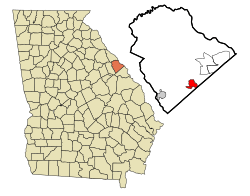Grovetown, Georgia facts for kids
Quick facts for kids
Grovetown, Georgia
|
||
|---|---|---|
|
||
| Motto(s):
A community that cares
|
||

Location in Columbia County and the state of Georgia
|
||
| Country | United States | |
| State | Georgia | |
| County | Columbia | |
| Incorporated | January 1, 1881 | |
| Area | ||
| • Total | 5.29 sq mi (13.69 km2) | |
| • Land | 5.27 sq mi (13.65 km2) | |
| • Water | 0.01 sq mi (0.03 km2) | |
| Elevation | 482 ft (147 m) | |
| Population
(2020)
|
||
| • Total | 15,577 | |
| • Density | 2,954.67/sq mi (1,140.81/km2) | |
| est. | ||
| Time zone | UTC-5 (Eastern (EST)) | |
| • Summer (DST) | UTC-4 (EDT) | |
| ZIP Code |
30813
|
|
| Area code(s) | 706 | |
| FIPS code | 1335716 | |
| GNIS feature ID | 356123 | |
Grovetown is a friendly city located in Columbia County, Georgia, in the United States. It's part of the larger Augusta metropolitan area. According to the 2020 census, 15,577 people lived here. The current mayor is Gary Jones.
Contents
A Look Back: Grovetown's History
Grovetown has a rich history! For a while, before the 1860s, it was known as "Belair." The city officially became a town on January 1, 1881. It's believed that Grovetown got its name from the old Grove Baptist Church, which started way back in 1808.
A famous poet named Paul Hamilton Hayne lived here in the 1860s. He helped set up the first post office in Grovetown. Mail service began on September 28, 1877. Charles Clifford was the first postmaster, and he also worked at the train station and owned a local store.
Train Stations and Travel
The first train station was built in 1878. A fancier, larger station was built in 1891. This station served the people of Grovetown until 1970. That's when passenger trains stopped using the line between Augusta and Atlanta. The old station was taken down in 1973.
Long ago, many people from Augusta built summer homes in Grovetown. They came to escape the hot city weather. They traveled by a special train called the "Picayune." The Rosland Hotel, also known as the "Eagle," was built in the 1880s. It had a big round room, called a rotunda, used for many events. These included church meetings, dinners, parties, and dances. The hotel later became a place where people could rent rooms. It burned down in the 1970s. Today, a church stands where the hotel once was.
Famous Faces and Growing Pains
Many small country stores opened along Old Wrightsboro Road. One famous spot was S. F. Poole's store. It had a special "philosophers' bench" outside. This was a place where older gentlemen would gather to chat about town news.
Some important people lived in Grovetown during its early days. These included the poet Hayne, cotton traders Stewart Phinizy and James Tobin, and banker Charles Phinizy. Dr. H. H. Steiner was a local doctor. John Dodge, a pharmacist, loved harness racing. He even brought his horses from Ohio and built a big home with a racetrack.
In 1942, Camp Gordon was built nearby. This caused Grovetown to grow very quickly. It changed from a small farming town to a busier community. Many military families chose to live in Grovetown because it was close to Fort Gordon. Over time, more and more retired military members also settled here. This helped the town's population grow steadily.
The town has expanded, and new homes have been built. This has made Grovetown's population much larger. Today, the city has about 15,577 people, a big increase from 3,596 in 1990. Grovetown offers many stores, restaurants, schools, and churches. It also has fun places like parks, a public safety department, two fire stations, and a museum.
On October 10, 2025, a freight train had an accident with a large truck. The truck got stuck while crossing the railroad tracks. This happened at the intersection of Katherine Street and Old Wrightsboro Road. This was the third time an incident occurred at this railroad crossing since 2002.
Grovetown's Location and Landscape
Grovetown is located in the southern part of Columbia County, Georgia. It is about 15 miles (24 km) east of downtown Augusta. The northern edge of Fort Gordon is just 2 miles (3.2 km) south of Grovetown.
The city covers a total area of about 5.29 square miles (13.69 square kilometers). Only a tiny part of this area, about 0.01 square miles (0.03 square kilometers), is water.
Weather and Climate Extremes
Grovetown has experienced some interesting weather events. The strongest tornado to hit the area was an EF2 tornado on October 31, 2019. Hurricane Helene also affected the town on September 27, 2024.
The hottest temperature ever recorded was 108°F (42°C). This happened on August 10, 2007, and again on August 21, 1983. The coldest temperature was −1°F (−18°C), recorded on January 21, 1985.
| Climate data for Augusta Daniel Field Airport, Georgia (1991–2020 normals, extremes 1871–present) | |||||||||||||
|---|---|---|---|---|---|---|---|---|---|---|---|---|---|
| Month | Jan | Feb | Mar | Apr | May | Jun | Jul | Aug | Sep | Oct | Nov | Dec | Year |
| Record high °F (°C) | 84 (29) |
88 (31) |
93 (34) |
96 (36) |
101 (38) |
106 (41) |
107 (42) |
108 (42) |
106 (41) |
101 (38) |
90 (32) |
84 (29) |
108 (42) |
| Mean maximum °F (°C) | 76 (24) |
79 (26) |
85 (29) |
89 (32) |
94 (34) |
98.2 (36.8) |
100 (38) |
99 (37) |
95 (35) |
89 (32) |
82 (28) |
73 (23) |
101 (38) |
| Mean daily maximum °F (°C) | 59.6 (15.3) |
63.5 (17.5) |
71.0 (21.7) |
78.5 (25.8) |
85.9 (29.9) |
91.3 (32.9) |
94.1 (34.5) |
92.6 (33.7) |
87.8 (31.0) |
79.0 (26.1) |
69.1 (20.6) |
61.5 (16.4) |
77.8 (25.4) |
| Daily mean °F (°C) | 47.4 (8.6) |
52.1 (11.2) |
57.5 (14.2) |
64.6 (18.1) |
72.7 (22.6) |
79.7 (26.5) |
80.9 (27.2) |
81.8 (27.7) |
76.4 (24.7) |
66.0 (18.9) |
55.6 (13.1) |
49.4 (9.7) |
65.4 (18.6) |
| Mean daily minimum °F (°C) | 35.3 (1.8) |
38.1 (3.4) |
44.1 (6.7) |
50.1 (10.1) |
59.6 (15.3) |
70.3 (21.3) |
71.6 (22.0) |
71.0 (21.7) |
65.0 (18.3) |
53.1 (11.7) |
42.2 (5.7) |
37.3 (2.9) |
53.0 (11.7) |
| Mean minimum °F (°C) | 18 (−8) |
21 (−6) |
26 (−3) |
34 (1) |
44 (7) |
60.2 (15.7) |
63 (17) |
61 (16) |
50 (10) |
35 (2) |
25 (−4) |
19 (−7) |
16 (−9) |
| Record low °F (°C) | −1 (−18) |
3 (−16) |
12 (−11) |
26 (−3) |
35 (2) |
46 (8) |
54 (12) |
52 (11) |
36 (2) |
22 (−6) |
11 (−12) |
5 (−15) |
−1 (−18) |
| Average precipitation inches (mm) | 3.84 (98) |
3.67 (93) |
4.08 (104) |
2.92 (74) |
3.05 (77) |
4.75 (121) |
3.99 (101) |
4.61 (117) |
3.60 (91) |
2.56 (65) |
2.66 (68) |
3.87 (98) |
44.09 (1,120) |
| Average snowfall inches (cm) | 0.4 (1.0) |
0.3 (0.76) |
0.0 (0.0) |
0.0 (0.0) |
0.0 (0.0) |
0.0 (0.0) |
0.0 (0.0) |
0.0 (0.0) |
0.0 (0.0) |
0.0 (0.0) |
0.0 (0.0) |
0.1 (0.25) |
0.8 (2.0) |
| Average precipitation days (≥ 0.01 in) | 9.9 | 10.2 | 8.6 | 7.6 | 7.9 | 11.1 | 8.3 | 11.1 | 7.9 | 6.4 | 7.0 | 9.4 | 107.3 |
| Average snowy days (≥ 0.1 in) | 0.4 | 0.1 | 0.0 | 0.0 | 0.0 | 0.0 | 0.0 | 0.0 | 0.0 | 0.0 | 0.0 | 0.1 | 0.5 |
| Average relative humidity (%) | 69.8 | 65.8 | 65.0 | 64.5 | 69.6 | 71.3 | 73.9 | 76.5 | 76.2 | 73.3 | 71.9 | 71.6 | 70.8 |
| Source: NWS Climate Summaries | |||||||||||||
Who Lives in Grovetown? Demographics
| Historical population | |||
|---|---|---|---|
| Census | Pop. | %± | |
| 1900 | 527 | — | |
| 1910 | 558 | 5.9% | |
| 1920 | 425 | −23.8% | |
| 1930 | 267 | −37.2% | |
| 1960 | 1,396 | — | |
| 1970 | 3,169 | 127.0% | |
| 1980 | 3,384 | 6.8% | |
| 1990 | 3,596 | 6.3% | |
| 2000 | 6,089 | 69.3% | |
| 2010 | 11,216 | 84.2% | |
| 2020 | 15,577 | 38.9% | |
| U.S. Decennial Census | |||
According to the 2020 United States census, Grovetown had 15,577 residents. There were 4,028 households and 2,986 families living in the city at that time.
The table below shows the different groups of people who make up Grovetown's population.
| Race | Num. | Perc. |
|---|---|---|
| White (non-Hispanic) | 6,309 | 40.5% |
| Black or African American (non-Hispanic) | 5,492 | 35.26% |
| Native American | 36 | 0.23% |
| Asian | 380 | 2.44% |
| Pacific Islander | 42 | 0.27% |
| Other/Mixed | 1,133 | 7.27% |
| Hispanic or Latino | 2,185 | 14.03% |
Fun and Games: Parks and Recreation
Grovetown has several great parks for everyone to enjoy! These include the Liberty Park Community Center and Goodale Park. Goodale Park is named after Joseph Daniel "Danny" Goodale Jr., a brave Vietnam veteran.
The city also has Kiddie Park, which is perfect for younger children, and Historical Park. Friendship Park is located near the Veterans wall on Robinson Avenue and is also known as Freedom Park. You can also find Wildflower Park at the corner of Robinson Avenue and Johns Street.
Learning in Grovetown: Education
Grovetown is part of the Columbia County School District. This district serves all the schools in Columbia County.
Several schools are right within Grovetown. These include Grovetown Middle School, Grovetown Elementary School, Grovetown High School, and Cedar Ridge Elementary School. Other schools like Columbia Middle School, Brookwood Elementary School, Euchee Creek Elementary School, and Baker Place Elementary School are also very close by.
How Grovetown Works: Infrastructure and Transportation
Getting around Grovetown is easy with its main roads. Georgia State Route 223 (SR 223) is a key road. It's known as Robinson Avenue for part of its path, then becomes Wrightsboro Road.
Another important road is SR 388. It also uses the name Wrightsboro Road for a section. This road eventually turns onto Horizon South Parkway. Harlem–Grovetown Road helps connect Grovetown to the nearby town of Harlem.
You'll also see CSX Transportation railroad tracks running through Grovetown. These tracks are mainly used by freight trains carrying goods.
See also
 In Spanish: Grovetown para niños
In Spanish: Grovetown para niños


